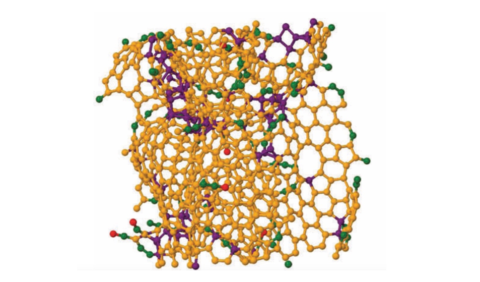
This image represents an 800-atom FEAR model of amorphous carbon at density 0.95 gm/cc. Spheres represent carbon atoms. Orange atoms are members of amorphous graphene subnetwork.
By Amanda Biederman
NQPI editorial intern
A team of Ohio University researchers and their collaborators used a theoretical model to characterize the physical properties of certain samples of amorphous carbon and showed that these materials are, in fact, connected and distorted fragments of amorphous graphene in an article published in Physical Chemistry Chemical Physics last month.
The paper, titled “Amorphous graphene: a constituent part of low density and amorphous carbon,” was authored by physics doctoral student Bishal Bhattarai, former postdoctoral researcher Parthapratim Biswas, former doctoral student and OHIO alum Raymond Atta-Fynn, and Dr. David Drabold, Distinguished Professor of Physics & Astronomy. The work was funded by the National Science Foundation. Atta-Fynn earned an M.S. in Mathematics in 2002 and a Ph.D. in Physics in 2005 from the College of Arts & Sciences.
Amorphous carbon is a reactive form of carbon that lacks a crystalline (ordered) structure. Many researchers are interested in studying films of amorphous carbon due to the compound’s unique properties and many applications. However, previously established techniques for studying amorphous materials have been limited by biasing assumptions or models too small to provide conclusive evidence.
The team developed a novel approach to study amorphous materials generally and applied it to carbon. The technique, called force enhanced atomic refinement (FEAR), infers a structural model jointly employing high-quality experimental data and accurate calculations of total energies and forces.
“This is the first convincing evidence that amorphous graphene exists in three-dimensional phases of amorphous carbon at low densities (below 1 gm/cc),” Drabold said.
Abstract: In this paper, we provide evidence that low density nano-porous amorphous carbon (a-C) consists of interconnected regions of amorphous graphene (a-G). We include experimental information in producing models while retaining the power and accuracy of ab initio methods with no biasing assumptions. Our models are highly disordered with predominant sp2 bonding and ring connectivity mainly of sizes 5–8. The structural, dynamical and electronic signatures of our 3-D amorphous graphene are similar to those of monolayer amorphous graphene. We predict an extended x-ray absorption fine structure (EXAFS) signature of amorphous graphene. Electronic density of states calculations for 3-D amorphous graphene reveal similarity to monolayer amorphous graphene and the system is non conducting.



















Comments